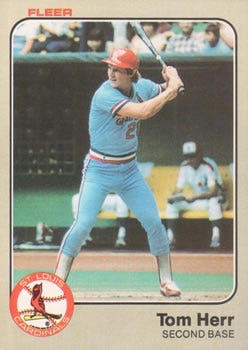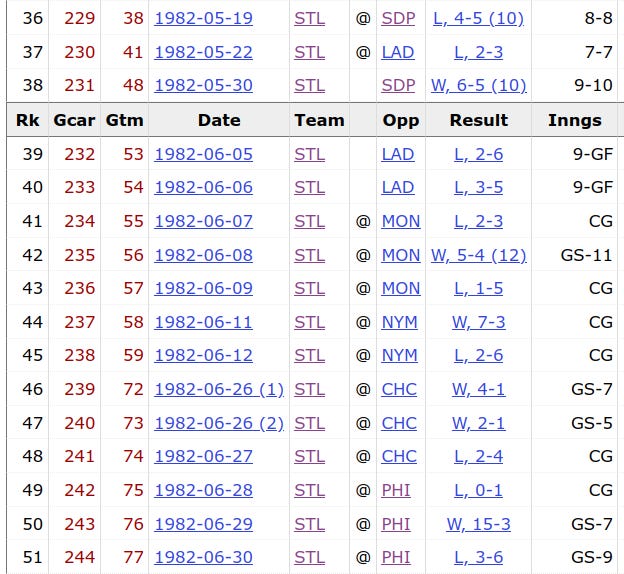Tom Herr In 1982
Since we talked all about Pete Vuckovich’s interesting 1982 season yesterday, we might as well talk about Tom Herr’s 1982 season today.
These two posts were inspired by this interesting Delphi Forums post from April 2019:
Now, the first thing to keep in mind is that both of these phenomena — Vuckovich allowing fewer runs than expected with runners on base, and Herr driving in fewer runs than expected with runners on base — are largely dependent on how their teammates performed. In other words, they touch on the sort of thing that baseball sims in general simply can’t get right.
There’s a chance that Herr somehow was unable to produce with runners on base, just as there’s a chance that Vuckovich suddenly developed the superhuman ability to prevent all the runners he allowed to reach base from scoring. However, there’s a much better chance that both of these players encountered varying degrees of luck.
We dug into Vuckovich yesterday, so let’s dig into Herr today.
Tom Herr’s 1982 season is odd because he managed to accumulate 158 total bases, and yet he only drove in 36 runs.
Herr managed to get this interesting total base number despite not hitting any home runs in 1982. Remember that this is back when Whitey Herzog’s Cardinals were designed around speed and keeping the ball in the ballpark. Herr’s offensive breakdown looks like this:
Singles: 108
Doubles: 19
Triples: 4
Home runs: 0
That adds up to the interesting total of 158 total bases, good enough for 68th on the National League leaderboard. Of course, Herr was nowhere near the leaders in terms of total bases:
Notice, by the way, that all of those players had RBI totals in the 80s or above. Driving in only 36 runs despite getting all those base hits is a pretty interesting “accomplishment.”
So what’s going on here?
Well, the most obvious thing to look at is where Herr wound up in the batting order. If Herr didn’t have a lot of players on base in front of him, he naturally wasn’t going to drive in a lot of runs — especially since he never hit a single home run.
Tom started out the season batting second, behind Lonnie Smith:
Herr was then relegated to 8th in the lineup, presumably because he was only hitting .234 with basically no power in early May:
Tom’s offense didn’t improve much, leading him to come off the bench for most of the month of June:
During this time, Whitey Herzog experimented a bit with Mike Ramsey at second base. Ramsey wasn’t much of a player, though, and so Herzog went back to Herr.
By early July, Herr was back to hitting second:
And then he finished off the season hitting first, with the faster Lonnie Smith relegated to the second spot in the batting order:
The rest of the season pretty much looks like this.
Now, the reason why Herr didn’t drive in a lot of runs is simply because the table was never set for him. This is blindingly obvious when you look at Tom’s situational splits:
Herr had 368 plate appearances with the bases empty in 1982. He only had 193 plate appearances with men on base.
It’s not that Herr hit poorly with men on base. In fact, his slugging percentage was higher, and his batting average was higher, his on base percentage was higher.
Now, with runners in scoring position (i.e. a runner on at least second base), his stats weren’t much better:
But that doesn’t mean much. We’re looking at only 137 plate appearances, after all.
It just so happens that Herr hit a little bit better in those 56 times when he had only a runner on first base than he did in the 137 times he had at least a runner on second.
The thing is that we’re dealing with numbers that are so small that it’s nothing but statistical noise. Herr got 17 hits in those 56 plate appearances with only a runner on first base. He got 26 hits in the 137 plate appearances with at least a runner on second base. This is mostly the result of luck — or statistical noise — because he didn’t have many chances with runners on base to begin with.
This is what happens when you start dividing up statistics in hopes of getting all the splits right. In fact, this is a pretty good representation of the problem you encounter when you try to get the left-right splits to match up perfectly. The more precise you design your system, the bigger the chances are that statistical noise will creep in and make everything fall apart.
Let’s look at the bigger picture. This is what Herr’s splits in all three situations look like for his entire career:
As is usually the case, when we increase plate appearances to a larger sample, the statistical noise goes away. Herr hit better with runners in scoring position than with nobody on base for his career. And he was quite a bit better with a runner on first base than with nobody on at all.
Now, his hitting ability with a runner on first base was almost certainly caused by the sort of baseball Whitey Herzog’s teams would play. Herr was often hitting in hit-and-run situations with a runner on at first regardless of the game situation. It’s really not unusual to expect him to hit a little bit better when the runner on first takes off and a big hole opens up on the right side of the infield.
If you replay the 1982 St. Louis Cardinals season and you want Herr to not drive in a ton of players, it’s actually pretty easy. Just put him in the lineup where Herzog put him. Have him hit first or second, and when he hits second have him hit behind Lonnie Smith.
You don’t need to do much else. You don’t need to come up with some special rating to punish Herr in the clutch, just like how you don’t need to come up with a special rating to help Vuckovich get players out with runners on base. All you need to do is have Herr hit the way he did in real life, and rate the Brewers’ defense accordingly, and the rest will sort itself out.
This, by the way, is why replays done with simpler game engines tend to give better results than replays done with engines that compensate for all the nitpicky stuff. The more you try to adjust for statistical noise, the more likely it is that you’ll miss the actual signal behind the noise.















I would be curious to look at Herr's 1985 season where he had 110 RBI with only 8 home runs. I'm sure having Vince Coleman and Willie McGee batting in front of him helped. :-) But from a WAR perspective (5.6), it was the best season of his career.
I 100 percent agree with you with the Herr factor and mostly agree with you on Vuckovich factor. Only thing is just like hitters sometimes would gives themselves up to hit behind the runner or put a ball in play, pitchers do not always pitch the same when nobody is on and when runners are on base. Especially back when going the distance was always in play.
A good example of this was the one Geoff wrote about with Catfish Hunter in issue 5 of the Sports Games Journal.
https://www.facebook.com/groups/Sportsgamesjournal/
This might be a little to nuance though for these games, but if they do have at least a small way to nudge things I am OK with that. But also see the case for let the chips fall as well